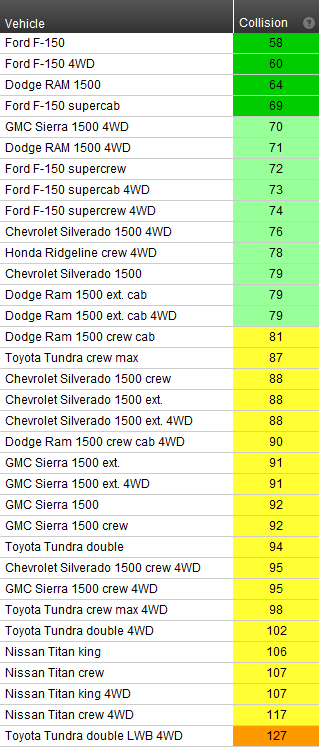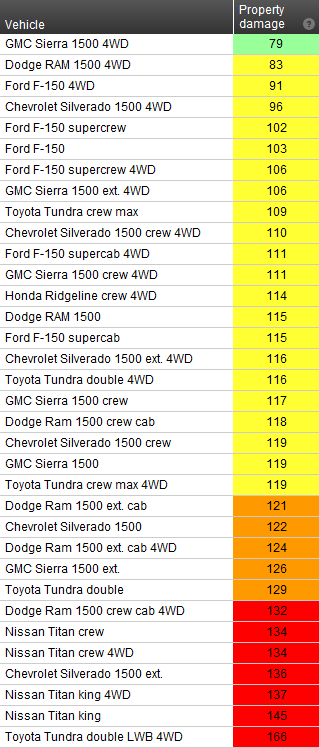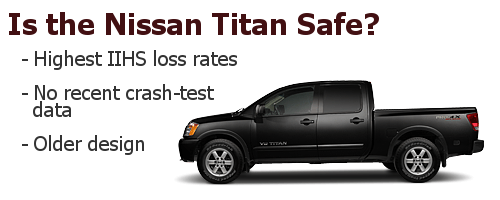Insurance Data Says F150 Best, Nissan Titan Worst
Jason Lancaster | Sep 21, 2012 | Comments 5
The IIHS (Insurance Institue for Highway Safety) is an impartial source of vehicle safety info, such as crash test data, insurance loss rates, and more. Yesterday, the IIHS website shared some information about average loss rates by vehicle make and model, separately reporting loss rates on collisions, personal injury claims, etc. You can view the data for yourself here.

Is the F150 the safest truck on the road? Based on the below-average collision and property damage loss rates, it certainly could be.
However, if you want the long and short of it, the data boils down to this: The F150 has the lowest loss rates, and the Nissan Titan has absolutely the worst. The Tundra is about average.
2009-2011 Pickup Truck Collision and Property Damage Loss Rates
The tables below show the loss rates for 2009-2011 half-ton trucks as a percentage of the average, meaning that a score of “90” represents a 90% of average loss rate, while a score of “120” represents a loss rate that’s 120% the average. Obviously, lower scores are better.
The first table below shows collision loss rates. While there are some models that fall higher or lower on the scale, the majority of the F150 models are firmly in the green, with collision loss rates of 74% or less. Note that all Nissan models are pulling up the rear here, although they’re only a few percentage over average.

Collison loss rates as a percentage of the average for all 2009-2011 full-size pickups
What this data means: Basically, it means that F150 drivers are less likely to file a collision claim and/or that the average repair cost of F150 collisions is lower than most models.
NOTE: Yes, there is a Tundra at the very bottom of the list, but it’s a long-box 4×4 truck…it’s safe to say this data point is anomalous since that’s a relatively rare bird, not to mention that every other Tundra model is about average or less.
The next table shows property damage loss rates, which are generally above average for most trucks. This makes quite a bit of sense, as a truck does more damage in a crash than a small car would. However, once again we see the same trend – the F150 occupies the top half of the list, the Nissan occupies the bottom, and the rest of the models are pretty evenly distributed from top to bottom.

Property damage loss rates as a percentage of the average for all 2009-2011 full-size pickups.
What this data means: The fact that the F150 sits in the top portion of the list is a pretty good indicator that F150 drivers do less damage when they crash and/or that the dollar amount of damage caused by F150 drivers is lower than average.
Is The F150 The Safest Truck on the Road?
While this IIHS data is very noisy, it would seem to indicate that the F150 is safer than the rest of the trucks on the market today. The F150 has done well in NHTSA crash tests, and the latest IIHS crash test ratings of the 2009+ F150 are quite good. The F150 is without a doubt a safe truck, and the great crash test ratings combined with these below-average loss rates would seem to indicate the F150 is very, very safe.
HOWEVER, when looking at data like this, it’s important to remember that the relative loss ratings are more about drivers than vehicles.
If, for example, there are a lot of 2009-2011 F150 owners who are 67 year old men that drive their trucks 5,000 miles a year, only during good weather, and only when traffic is low (like a certain relative of mine), the loss rates are going to be astronomically low.
Or, if many F150 owners live in rural areas (Ford has a lot of rural dealerships selling trucks), they’re highly unlikely to file a collision or property damage claim (remember, single-vehicle accident claims fall under the comprehensive portion of the average policy).
Finally, if the average F150 owner is an older American, the loss rates are going to be lower no matter what they do or where they live, as older Americans are generally safer drivers.
Is the Titan Safe?

Is the Nissan Titan safe? Compared to the average car, almost certainly. However, when compared to other new half-ton trucks, there are doubts.
As explained above, while this loss rate data is interesting, it’s just as likely to be a reflection of the average Nissan Titan driver as it is anything else. I would posit that Nissan Titan owners are typically younger: partially because Nissan is a brand popular with young drivers, and partially because the Titan is the least costly new truck available. Generally speaking, younger drivers have less costly vehicles. Younger drivers are also a little more likely to have a wreck, and that fact could explain the Titan’s higher-than-average loss rates.
Still, the fact is that the Titan hasn’t been tested by NHTSA since they rolled out the new crash test rating system in 2011, and the IIHS has never tested the Titan for side impact safety. Considering the age of the Titan’s design, it’s entirely possible that the Titan is the least crash-worthy half-ton truck available.
So, is the Titan safe? Compared to the average car on the road, almost certainly. Compared to the F150, Tundra, Chevy and GMC, or Ram? Probably not as safe as it could be.
What do you think of all of his loss rate data? Interesting, or worthless?
Search terms people used to find this page:
- tundraheadquarters
Filed Under: Auto News


A big improvement since the 2003 model F-150.
those stats don’t mean a thing to me. I thought test results showed the crash tests best on the tundra over the big 3?
Nissan Titan’s are butt ugly, don’t know why anyone would want one at all. I’d for sure take the big 3 over the Nissan being last for sure.
MK,
Agreed. The Titan isn’t really friendly on the eyes.
-Tim
It depends on how well former owners took care of & how hard they drove it.Have compression check,check for water in oil,check wear on front end & wheel cylinders & cond of Brakes & all rubber lines.
Yes! The F150 is a good truck but personally I’d stay away from it unless it’s been rebuilt very recently and they’ve all the paper work to back it up plus it’s a extremely good low price.Again never buy any used vehicle unless you can have a reliable shop check it over for you before hand.